Novel Arrangement of Denitrification Reactors in a Recirculating Aquaculture System
a technology of denitrification reactor and aquaculture system, which is applied in the direction of biological water/sewage treatment, water treatment parameter control, water/sewage treatment by degassing, etc., can solve the problems of increasing the generation of nitrogenous waste, increasing the number of nitrogenous waste, etc., to achieve the effect of maximizing the survival of aquatic reared species and facilitating the determination of appropriate water chemistry profiles
- Summary
- Abstract
- Description
- Claims
- Application Information
AI Technical Summary
Benefits of technology
Problems solved by technology
Method used
Image
Examples
example
[0065]To test the effectiveness of the novel arrangement of denitrification reactors positioned upstream of aerobic nitrification processes, an experimental set-up of a commercial aquaculture system for holding 6 metric tons (mt) of Siberian sturgeon (Acipenser baeri) was used to generate nitrate. Water from four 70 m3 fish tanks flowed by gravity through fiberglass troughs and PVC pipes and an open channel to a rotating 60 μm drum screen filter (PR Aqua Rotofilter, Nanaimo BC, Canada) for solids removal before flowing into nitrification reactors containing 25 m3 of aerated extruded plastic media (AMB™ media, EEC, Blue Bell, Pa.). Water processed through the drum screen filter was pumped to denitrification reactors located near the rotating drum filter at a flow rate of 10 lpm / filter for denitrification processes. For experimental purposes, three pumps delivered water to each of four denitrification units (one-pump / four-denitrification units) and each denitrification unit had a sepa...
PUM
 Login to View More
Login to View More Abstract
Description
Claims
Application Information
 Login to View More
Login to View More - R&D
- Intellectual Property
- Life Sciences
- Materials
- Tech Scout
- Unparalleled Data Quality
- Higher Quality Content
- 60% Fewer Hallucinations
Browse by: Latest US Patents, China's latest patents, Technical Efficacy Thesaurus, Application Domain, Technology Topic, Popular Technical Reports.
© 2025 PatSnap. All rights reserved.Legal|Privacy policy|Modern Slavery Act Transparency Statement|Sitemap|About US| Contact US: help@patsnap.com



